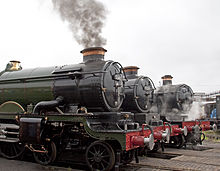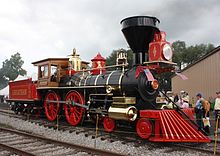- Chimney (locomotive)
-
 Great Western locomotives with their distinctive copper-rimmed chimneys
Great Western locomotives with their distinctive copper-rimmed chimneys
The chimney (or smokestack in North America) of a steam locomotive is a part of the exhaust system which helps in the creation of draught through the boiler and carries the exhaust steam and smoke clear of the driver's line of sight. Different designs also helped create distinctive aesthetic looks for different companies and designers.
Contents
Position
The chimney was usually located above the smokebox at the leading end of the locomotive, furthest away from the driver's cab.
Construction
In Great Britain, and British built locomotives, chimneys were usually of cast-iron construction, as it was found to last longer than fabricated types. Fabricated construction was more common where spark arrestors were used, due to the difficulty of casting this complicated feature.
Aesthetics
Many designers or railway companies had their own distinctive style, such as the William Adams' "Stovepipe" chimney on the 19th century LSWR, or the copper-capped chimneys on the Great Western Railway. The look of the chimney was also affected on locomotives that burned wood or turf, or ran through areas of high fire-risk, by the addition of a large spark arrester which were known as "balloon stacks" in North America.
Function and internal design
The chimney served 2 main purposes:
- To lift the exhaust gases (smoke and steam) above the locomotive, keeping them clear of the driver's view of the track ahead.
- Together with the blastpipe it created a vacuum in the smokebox which then induced a draught through the boiler flues from the firebox.
In order to achieve these functions, the internal dimensions of the chimney were critical, as well as its positioning relative to the blastpipe, but this was not widely understood until well into the 20th century.
As locomotive boilers grew larger, the space available for chimneys was reduced, as they still had to fit within the same loading gauge. This reduced their effectiveness at keeping the exhaust gases away from the driver's line of sight, and as a result locomotives had to be fitted with devices such as smoke deflectors.
Development
George Jackson Churchward, working at Swindon on the GWR, formulated a simple equation for calculating the ideal dimensions for chimneys which worked well for the early years of the 20th century, but soon become outdated as engine powers increased.
André Chapelon in France continued to work on chimney dimensions, and studied them in conjunction with blastpipe dimensions as a complete Steam locomotive exhaust system, such as his famous Kylchap system as fitted to many locomotive classes worldwide.
Even after the end of commercial steam in most of the developed world, the Argentinean engineer Livio Dante Porta continued to work on developing steam locomotive exhaust systems including refining equations to give better chimney dimensions.
Steam locomotive exhaust systems Exhaust system types Common exhaust system elements Categories:- Steam locomotive technologies
- Steam locomotive exhaust systems
- Locomotive parts
- Rail transport stubs
Wikimedia Foundation. 2010.

